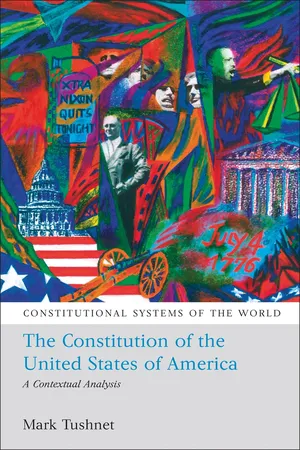History
Birth of the USA
The birth of the USA refers to the founding of the United States as an independent nation in 1776. This significant event was marked by the signing of the Declaration of Independence, which declared the 13 American colonies free from British rule. The birth of the USA laid the foundation for the development of a new democratic nation and the establishment of a unique system of government.
Written by Perlego with AI-assistance
Related key terms
2 Key excerpts on "Birth of the USA"
- eBook - ePub
- Hilde Eliassen Restad(Author)
- 2014(Publication Date)
- Routledge(Publisher)
154Nevertheless, America’s past was British and the Americans themselves were largely Britons, which meant that the new United States had to look to the future for a national identity, where nothing but ideas existed. American identity instantly became connected to an idea of exceptionalism, taken from the Puritans and forged in the fires of revolution as opposed to from a secular development of a “community through history.”155A more specific version of Stephanson’s argument is that of authors such as Tyrrell, who argues that American exceptionalism did not appear until the nineteenth century. Whereas the term “exceptional” used in the American context is commonly traced to Tocqueville in the 1830s – and was really not popularized until 1957 when Max Lerner wrote about “American exceptionalism” – this chapter has shown that the sentiments behind it “predated the creation of a summarizing term.”156 According to Greene’s investigation of early settler documents, it is clear that, in one form or another, a notion of distinctiveness was a significant component in intellectual constructs of America from the beginning.157 With the success of the Revolution came the thinking that the New World could be an example for the Old, argues Greene, serving as a model for the Europeans.158 Although the Puritans had surely already espoused this line of thinking, perhaps what Greene is referring to is America as a political model, in contrast to the Puritan project of being a religious model.159 Joyce Appleby dates the idea to a bit later, the mid 1790s, when the Revolution in France provided the Americans with further proof that their experiment was not simply an anomaly but rather the harbinger of a future political trend.160 Far from being the creation of later historians and social analysts, Greene concludes, “the concept of American exceptionalism with its positive connotations was present at the very creation of America.” By the time the nineteenth century came around the idea of America as an exceptional entity had long been an integral component in the American imagined community.161 - eBook - ePub
The Constitution of the United States of America
A Contextual Analysis
- Mark Tushnet(Author)
- 2008(Publication Date)
- Bloomsbury Publishing(Publisher)
1
An Overview of the History of the US Constitution
When in the late nineteenth century scholars began to write constitutional histories of the United States, they went back to the forest of Germany and Magna Carta to identify the origins of US constitutionalism. For our purposes a more compressed time frame is appropriate. This Chapter surveys constitutional developments from the Revolutionary era through the early twenty-first century, to provide some orientation to the analytical account of US constitutional development that will occupy the remainder of the book. A single short chapter is obviously inadequate to provide more than the barest sense of the course of constitutional development; we will return to some of the episodes noted here in later chapters, which will also provide additional examples that retrospectively fill in some details omitted here.FROM THE REVOLUTION TO THE BILL OF RIGHTS
The British colonies on the North American continent began to push for independence in the aftermath of the French and Indian Wars of the mid-eighteenth century. By the early 1770s a group of politically active colonists had become increasingly dissatisfied with the imposition on them of regulations adopted by the remote British Parliament in which they had no direct representation. They organized ‘committees of correspondence’ which began as local groups of independence-minded colonists who coordinated their efforts across colonies but which eventually became quasi-governments parallel to the colonial legislatures under British control.1Meeting in Philadelphia, the colonists declared independence in 1776. Organized as a ‘Continental Congress’ with representatives from each of the colonies, the rebels began to create something resembling a government for what they hoped would become a new and independent nation. That government was a loose confederation of the former colonies, now denominated ‘states’. Near the end of the decade the states decided to regularize their government by entering into a formal confederation. The Articles of Confederation were drafted in 1777 and became effective in 1781, during the Revolutionary War.
Learn about this page
Index pages curate the most relevant extracts from our library of academic textbooks. They’ve been created using an in-house natural language model (NLM), each adding context and meaning to key research topics.

